The Evolution of Landscape Patterns and Its Ecological Effects of Open-Pit Mining: A Case Study in the Heidaigou Mining Area, China
Abstract
:1. Introduction
2. Materials and Methods
2.1. Study Area
2.2. Data and Preprocessing
2.3. Methods
2.3.1. Land Use Transfer Analysis
2.3.2. Landscape Pattern Analysis
- (1)
- The Patch density
- (2)
- The Percent Plaque Area
- (3)
- The Landscape Shape Index
- (4)
- The Largest Patch Index
- (5)
- The Patch Cohesion Index
- (6)
- The Contagion Index
- (7)
- The Shannon’s Diversity Index
- (8)
- The Modified Simpson’s Evenness Index
2.3.3. The Remote Sensing Ecological Index (RSEI)
3. Results
3.1. Land Use/Land Cover Change Characteristics
3.2. Landscape Pattern Change Analysis
3.2.1. Landscape Pattern Change Characteristics at the Land Use/Cover Type Level
3.2.2. Landscape Pattern Change Characteristics at the Landscape Level
3.3. Evaluation of the Ecological Environment Quality of the Heidaigou Open-Pit Mine
3.3.1. The Remote-Sensing-Based Ecological Index (RSEI)
3.3.2. Analysis of Spatial and Temporal Changes in the Ecological Environment of the Mining Areas
3.3.3. Trends in the Changes of Ecological Quality
4. Discussion
4.1. Analysis of the Reasons for the Landscape Evolution Patterns of the Open-Pit Coal Mine
4.2. The Ecological Evaluation of Mines through Analyzing Landscape Pattern Changes
4.3. Limitations of the RSEI Index in the Evaluation of the Coal Mine Ecological Environment
5. Conclusions
- Changes in land use/land cover types are important drivers of landscape pattern evolution and changes in ecosystem quality.
- The changes in the ecological index of the Heidaigou mining landscape has fluctuated significantly over the past 15 years, mainly due to the mining activities and land reclamation work in the mine and the mining method of the open-pit coal mine. The changes in the ecological environment quality of the mining area first decreased and then increased, which was mainly influenced by human activities; the measure of “reclamation while mining” had a significant effect on the protection of the ecological environment in the mining area.
- The correlation between the landscape pattern evolution and the changes in remote sensing ecological indices was weak, and research work on mining-scale landscape patterns should be more in the study of ecosystem structure, function, productivity, stability, and ecological risk.
Author Contributions
Funding
Institutional Review Board Statement
Informed Consent Statement
Data Availability Statement
Conflicts of Interest
References
- Lambin, E.F.; Geist, H.J.; Lepers, E. Dynamics of Land-Use and Land-Cover Change in Tropical Regions. Annu. Rev. Environ. Resour. 2003, 28, 205–241. [Google Scholar] [CrossRef] [Green Version]
- Twisa, S.; Buchroithner, M.F. Land-Use and Land-Cover (LULC) Change Detection in Wami River Basin, Tanzania. Land 2019, 8, 136. [Google Scholar] [CrossRef] [Green Version]
- Larondelle, N.; Haase, D. Valuing post–mining landscapes using an ecosystem services approach—An example from Germany. Ecol. Indic. 2012, 18, 567–574. [Google Scholar] [CrossRef]
- Chang, X.; Zhang, F.; Cong, K.; Liu, X. Scenario simulation of land use and land cover change in mining area. Sci. Rep. 2021, 11, 12910. [Google Scholar] [CrossRef]
- Sun, C.; Li, X.; Zhang, W.; Li, X. Evolution of Ecological Security in the Tableland Region of the Chinese Loess Plateau Using a Remote-Sensing-Based Index. Sustainability 2020, 12, 3489. [Google Scholar] [CrossRef] [Green Version]
- Firozjaei, M.K.; Sedighi, A.; Firozjaei, H.K.; Kiavarz, M.; Homaee, M.; Arsanjani, J.J.; Makki, M.; Naimi, B.; Alavipanah, S.K. A historical and future impact assessment of mining activities on surface biophysical characteristics change: A remote sensing-based approach. Ecol. Indic. 2021, 122, 107264. [Google Scholar] [CrossRef]
- Nie, X.; Hu, Z.; Zhu, Q.; Ruan, M. Research on Temporal and Spatial Resolution and the Driving Forces of Ecological Environment Quality in Coal Mining Areas Considering Topographic Correction. Remote Sens. 2021, 13, 2815. [Google Scholar] [CrossRef]
- Zhang, F.; Yushanjiang, A.; Wang, D. Ecological risk assessment due to land use/cover changes (LUCC) in Jinghe County, Xinjiang, China from 1990 to 2014 based on landscape patterns and spatial statistics. Environ. Earth Sci. 2018, 77, 491. [Google Scholar] [CrossRef]
- Sun, Y.; Qian, S.; Yan, W.; Xu, L.; Wang, Y.; Cao, Y. Spatial-temporal dynamics of vegetation ecosystem in typical coal mining area of Yunnan Province during 2000–2018: A case study in Lincang. Ecol. Environ. Sci. 2019, 28, 2381–2389. [Google Scholar] [CrossRef]
- Mishira, P.P. Coal Mining and Rural Livelihoods. Econ. Polit. Wkly. 2009, 44, 117–123. Available online: http://environmentportal.in/files/Coal%20Mining%20and%20Rural%20Livelihoods.pdf (accessed on 30 October 2009).
- Saini, V.; Gupta, R.P.; Arora, M.K. Environmental impact studies in coalfields in India: A case study from Jharia coal-field. Renew. Sustain. Energy Rev. 2016, 53, 1222–1239. [Google Scholar] [CrossRef]
- Wang, X.; Chen, F.; Hasi, E.; Li, J. Desertification in China: An assessment. Earth-Sci. Rev. 2008, 88, 188–206. [Google Scholar] [CrossRef]
- Chen, W.; Li, X.; He, H.; Wang, L. A Review of Fine-Scale Land Use and Land Cover Classification in Open-Pit Mining Areas by Remote Sensing Techniques. Remote Sens. 2017, 10, 15. [Google Scholar] [CrossRef] [Green Version]
- El-Hamid, H.T.A.; Caiyong, W.; Yongting, Z. Geospatial analysis of land use driving force in coal mining area: Case study in Ningdong, China. GeoJournal 2019, 86, 605–620. [Google Scholar] [CrossRef]
- Qi, R.; Liu, T.; Jia, Q.; Sun, L.; Liu, J. Simulating the sustainable effect of green mining construction policies on coal mining industry of China. J. Clean. Prod. 2019, 226, 392–406. [Google Scholar] [CrossRef]
- Qi, R.; Li, S.; Qu, L.; Sun, L.; Gong, C. Critical factors to green mining construction in China: A two-step fuzzy DEMATEL analysis of state-owned coal mining enterprises. J. Clean. Prod. 2020, 273, 122852. [Google Scholar] [CrossRef]
- Li, Z.; Li, X.; Wang, Y.; Ma, A.; Wang, J. Land-use change analysis in Yulin prefecture, northwestern China using remote sensing and GIS. Int. J. Remote Sens. 2010, 25, 5691–5703. [Google Scholar] [CrossRef]
- Li, N.; Yan, C.Z.; Xie, J.L. Remote sensing monitoring recent rapid increase of coal mining activity of an important energy base in northern China, a case study of Mu Us Sandy Land. Resour. Conserv. Recycl. 2015, 94, 129–135. [Google Scholar] [CrossRef]
- Qisheng, X.; Jinman, W.; Wenting, S. Influence of Landscape Pattern Changes in Large-scale Open–pit Coal Mining Area on Soil Erosion: A Case Study on Pingshuo Mining Area in Shanxi Province. China Land Sci. 2022, 36, 96–106. [Google Scholar] [CrossRef]
- Shan, W.; Jin, X.; Ren, J.; Wang, Y.; Xu, Z.; Fan, Y.; Gu, Z.; Hong, C.; Lin, J.; Zhou, Y. Ecological environment quality assessment based on remote sensing data for land consolidation. J. Clean. Prod. 2019, 239, 118126. [Google Scholar] [CrossRef]
- Minelli, A.; Felice, E.; Marinelli, E.; Pasini, I.; Neri, D. Estimating leaf area indexes for 10 years of simultaneous or gradual renewal of an exhausted poplar tree avenue. In Acta Hortic. 2021, 1331, 303–310. [Google Scholar] [CrossRef]
- Garai, D.; Narayana, A.C. Land use/land cover changes in the mining area of Godavari coal fields of southern India. Egypt. J. Remote Sens. Space Sci. 2018, 21, 375–381. [Google Scholar] [CrossRef]
- Peng, J.; Zong, M.; Hu, Y.n.; Liu, Y.; Wu, J. Assessing Landscape Ecological Risk in a Mining City: A Case Study in Liaoyuan City, China. Sustainability 2015, 7, 8312–8334. [Google Scholar] [CrossRef] [Green Version]
- Qian, D.; Yan, C.; Xing, Z.; Xiu, L. Monitoring coal mine changes and their impact on landscape patterns in an alpine region: A case study of the Muli coal mine in the Qinghai-Tibet Plateau. Environ. Monit. Assess 2017, 189, 559. [Google Scholar] [CrossRef] [PubMed]
- Zhang, M.; Wang, J.; Li, S.; Feng, D.; Cao, E. Dynamic changes in landscape pattern in a large–scale opencast coal mine area from 1986 to 2015: A complex network approach. Catena 2020, 194, 104738. [Google Scholar] [CrossRef]
- Zhang, L.; Zhai, Z.; Zhou, Y.; Liu, S.; Wang, L. The Landscape Pattern Evolution of Typical Open–Pit Coal Mines Based on Land Use in Inner Mongolia of China during 20 Years. Sustainability 2022, 14, 9590. [Google Scholar] [CrossRef]
- Karan, S.K.; Samadder, S.R.; Maiti, S.K. Assessment of the capability of remote sensing and GIS techniques for monitoring reclamation success in coal mine degraded lands. J. Environ. Manag. 2016, 182, 272–283. [Google Scholar] [CrossRef]
- Song, W.; Song, W.; Gu, H.; Li, F. Progress in the Remote Sensing Monitoring of the Ecological Environment in Mining Areas. Int. J. Env. Res. Public Health 2020, 17, 1846. [Google Scholar] [CrossRef] [Green Version]
- Zhu, D.; Chen, T.; Zhen, N.; Niu, R. Monitoring the effects of open-pit mining on the eco–environment using a moving window–based remote sensing ecological index. Environ. Sci. Pollut. Res. Int. 2020, 27, 15716–15728. [Google Scholar] [CrossRef]
- Liu, H.; Jiang, Y.; Misa, R.; Gao, J.; Xia, M.; Preusse, A.; Sroka, A.; Jiang, Y. Ecological environment changes of mining areas around Nansi lake with remote sensing monitoring. Environ. Sci. Pollut. Res. Int. 2021, 28, 44152–44164. [Google Scholar] [CrossRef]
- Xiong, Y.; Xu, W.; Lu, N.; Huang, S.; Wu, C.; Wang, L.; Dai, F.; Kou, W. Assessment of spatial–temporal changes of ecological environment quality based on RSEI and GEE: A case study in Erhai Lake Basin, Yunnan province, China. Ecol. Indic. 2021, 125, 107518. [Google Scholar] [CrossRef]
- Mateo-García, G.; Gómez-Chova, L.; Amorós-López, J.; Muñoz-Marí, J.; Camps-Valls, G. Multitemporal Cloud Masking in the Google Earth Engine. Remote Sens. 2018, 10, 1079. [Google Scholar] [CrossRef] [Green Version]
- Ji, Y.; Bai, Z.; Hui, J. Landscape Ecological Risk Assessment Based on LUCC—A Case Study of Chaoyang County, China. Forests 2021, 12, 1157. [Google Scholar] [CrossRef]
- Wang, J.; Jiao, Z.; Bai, Z. Changes in carbon sink value based on RS and GIS in the Heidaigou opencast coal mine. Environ. Earth Sci. 2013, 71, 863–871. [Google Scholar] [CrossRef]
- Huang, L.; Zhang, P.; Hu, Y.; Zhao, Y. Vegetation succession and soil infiltration characteristics under different aged refuse dumps at the Heidaigou opencast coal mine. Glob. Ecol. Conserv. 2015, 4, 255–263. [Google Scholar] [CrossRef] [Green Version]
- Corner, R.J.; Dewan, A.M.; Chakma, S. Monitoring and Prediction of Land-Use and Land-Cover (LULC) Change. In Dhaka Megacity; Springer: New York, NY, USA, 2014; pp. 75–97. [Google Scholar] [CrossRef]
- Wu, J. Effects of changing scale on landscape pattern analysis: Scaling relations. Landsc. Ecol. 2004, 19, 125–138. [Google Scholar] [CrossRef]
- Riitters, K.H.; O’Neill, R.V.; Hunsaker, C.T.; Wickham, J.D.; Yankee, D.H.; Timmins, S.P.; Jones, K.B.; Jackson, B.L. A factor analysis of landscape pattern and structure metrics. Landsc. Ecol. 1995, 10, 23–39. [Google Scholar] [CrossRef]
- McGarigal, K. Landscape Pattern Metrics. In Encyclopedia of Environmetrics; Wiley Online Library: Hoboken, NJ, USA, 2006. [Google Scholar] [CrossRef]
- Bell, S. Landscape pattern, perception and visualisation in the visual management of forests. Landsc. Urban. Plan. 2001, 54, 201–211. [Google Scholar] [CrossRef]
- O’Neill, R.V.; Krummel, J.R.; Gardner, R.H.; Sugihara, G.; Jackson, B.; DeAngelis, D.L.; Milne, B.T.; Turner, M.G.; Zygmunt, B.; Christensen, S.W.; et al. Indices of landscape pattern. Landsc. Ecol. 1988, 1, 153–162. [Google Scholar] [CrossRef]
- Hassett, E.M.; Stehman, S.V.; Wickham, J.D. Estimating landscape pattern metrics from a sample of land cover. Landsc. Ecol. 2011, 27, 133–149. [Google Scholar] [CrossRef]
- Firozjaei, M.K.; Fathololoumi, S.; Weng, Q.; Kiavarz, M.; Alavipanah, S.K. Remotely Sensed Urban Surface Ecological Index (RSUSEI): An Analytical Framework for Assessing the Surface Ecological Status in Urban Environments. Remote Sens. 2020, 12, 2029. [Google Scholar] [CrossRef]
- Chen, Z.; Chen, J.; Zhou, C.; Li, Y. An ecological assessment process based on integrated remote sensing model: A case from Kaikukang-Walagan District, Greater Khingan Range, China. Ecol. Inform. 2022, 70, 101699. [Google Scholar] [CrossRef]
- Asner, G.P. Tropical forest carbon assessment: Integrating satellite and airborne mapping approaches. Environ. Res. Lett. 2009, 4, 34009. [Google Scholar] [CrossRef]
- Pettorelli, N.; Vik, J.O.; Mysterud, A.; Gaillard, J.M.; Tucker, C.J.; Stenseth, N.C. Using the satellite–derived NDVI to assess ecological responses to environmental change. Trend. Ecol. Evol. 2005, 20, 503–510. [Google Scholar] [CrossRef]
- Neteler, M. Estimating Daily Land Surface Temperatures in Mountainous Environments by Reconstructed MODIS LST Data. Remote Sens. 2010, 2, 333–351. [Google Scholar] [CrossRef] [Green Version]
- Park, S.H.; Jung, H.S. Band-Based Best Model Selection for Topographic Normalization of Normalized Difference Vegetation Index Map. IEEE Access 2020, 8, 4408–4417. [Google Scholar] [CrossRef]
- Gupta, K.; Kumar, P.; Pathan, S.K.; Sharma, K.P. Urban Neighborhood Green Index –A measure of green spaces in urban areas. Landsc. Urban. Plan. 2012, 105, 325–335. [Google Scholar] [CrossRef]
- Li, X.; Lei, S.; Cheng, W.; Liu, F.; Wang, W. Spatio–temporal dynamics of vegetation in Jungar Banner of China during 2000–2017. J. Arid. Land 2019, 11, 837–854. [Google Scholar] [CrossRef] [Green Version]
- Xu, H.; Wang, Y.; Guan, H.; Shi, T.; Hu, X. Detecting Ecological Changes with a Remote Sensing Based Ecological Index (RSEI) Produced Time Series and Change Vector Analysis. Remote Sens. 2019, 11, 2345. [Google Scholar] [CrossRef] [Green Version]
- Kang, S.; Niu, J.M.; Zhang, Q.; Han, Y.J.; Dong, J.J.; Zhang, J. Impacts of mining on landscape pattern and primary productivity in the grassland of Inner Mongolia: A case study of Heidaigou open pit coal mining. Acta Ecol. Sin. 2014, 34, 2855–2867. [Google Scholar] [CrossRef] [Green Version]
- Wu, J.G.; Luck, M. A gradient analysis of urban landscape pattern: A case study from the phoenix metropolitan region, Arizona, USA. Landsc Ecol. 2002, 17, 327–339. [Google Scholar] [CrossRef]
- Li, R.; Chen, G.Q.; Li, W.X.; Meng, R.; Wang, M.J.; Guo, Y.N. Spatiotemporal Analusis of Eco-environmental Benefits in Shenfu-Dongshen Mining Area During 1995–2020 Based on RSEI. Bull. Soil Conserv. 2021, 6, 143–151. [Google Scholar] [CrossRef]
- Xia, N. Study on Remote Sensing Monitoring of Eco-Environment and Assessment Model of Ecological Quality in Zhundong Mining Region. Ph.D. Thesis, Xinjiang University, Urumqi, China, June 2018. [Google Scholar]
- Han, L.; Li, Y.F.; Wu, C.Y.; Han, F.X. Evaluation of ecological restoration effect in Baorixile Open-pit Mine Area based on remote sensing ecological index. Int. J. Environ. Res. Public Health 2022, 31, 54–61. [Google Scholar] [CrossRef]
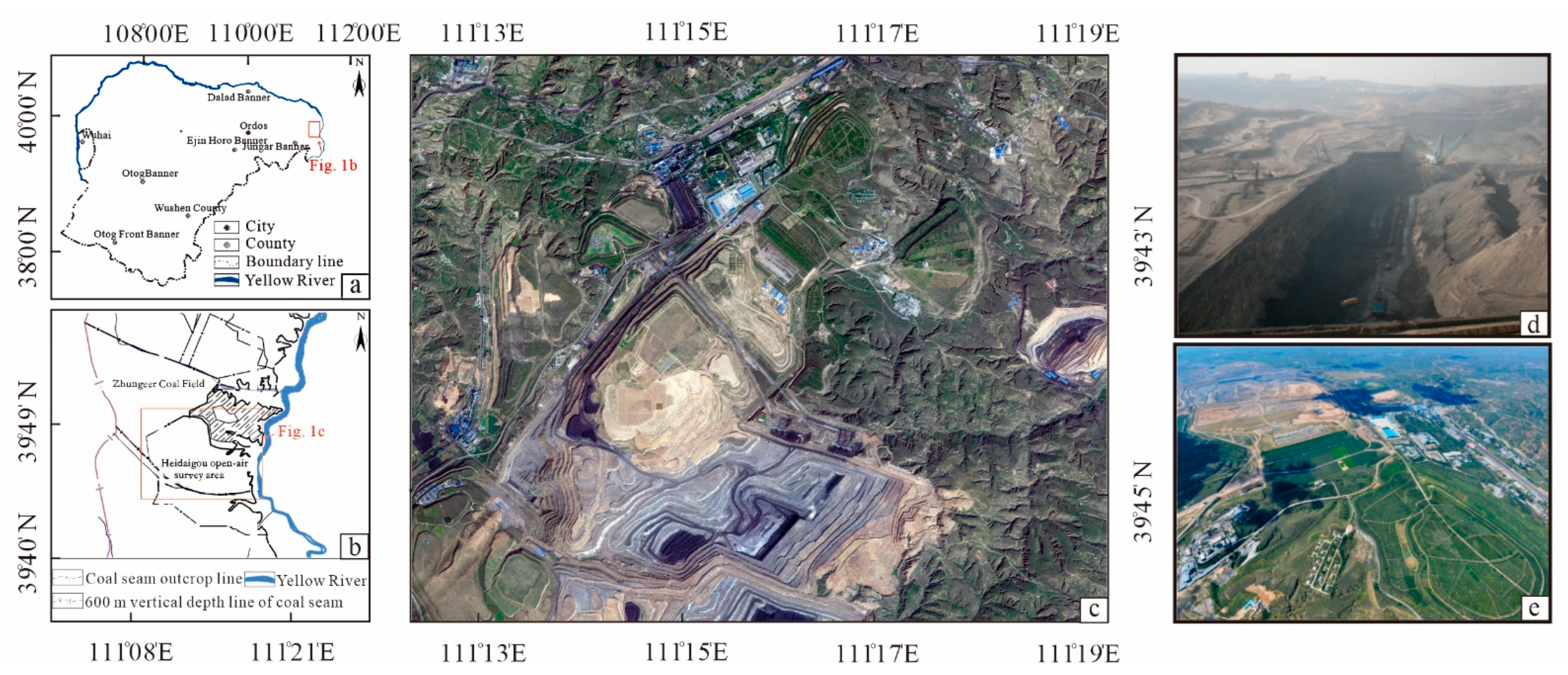



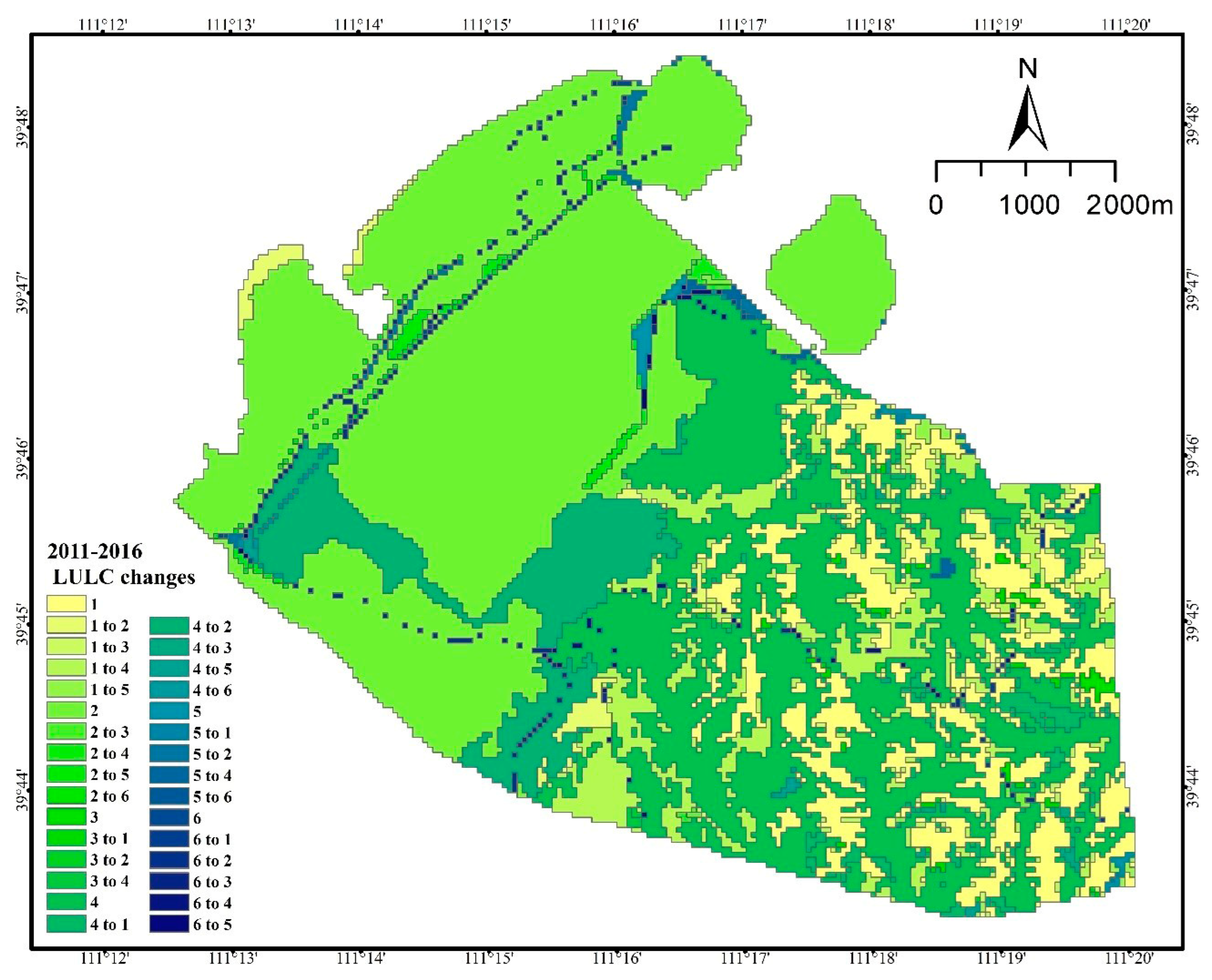

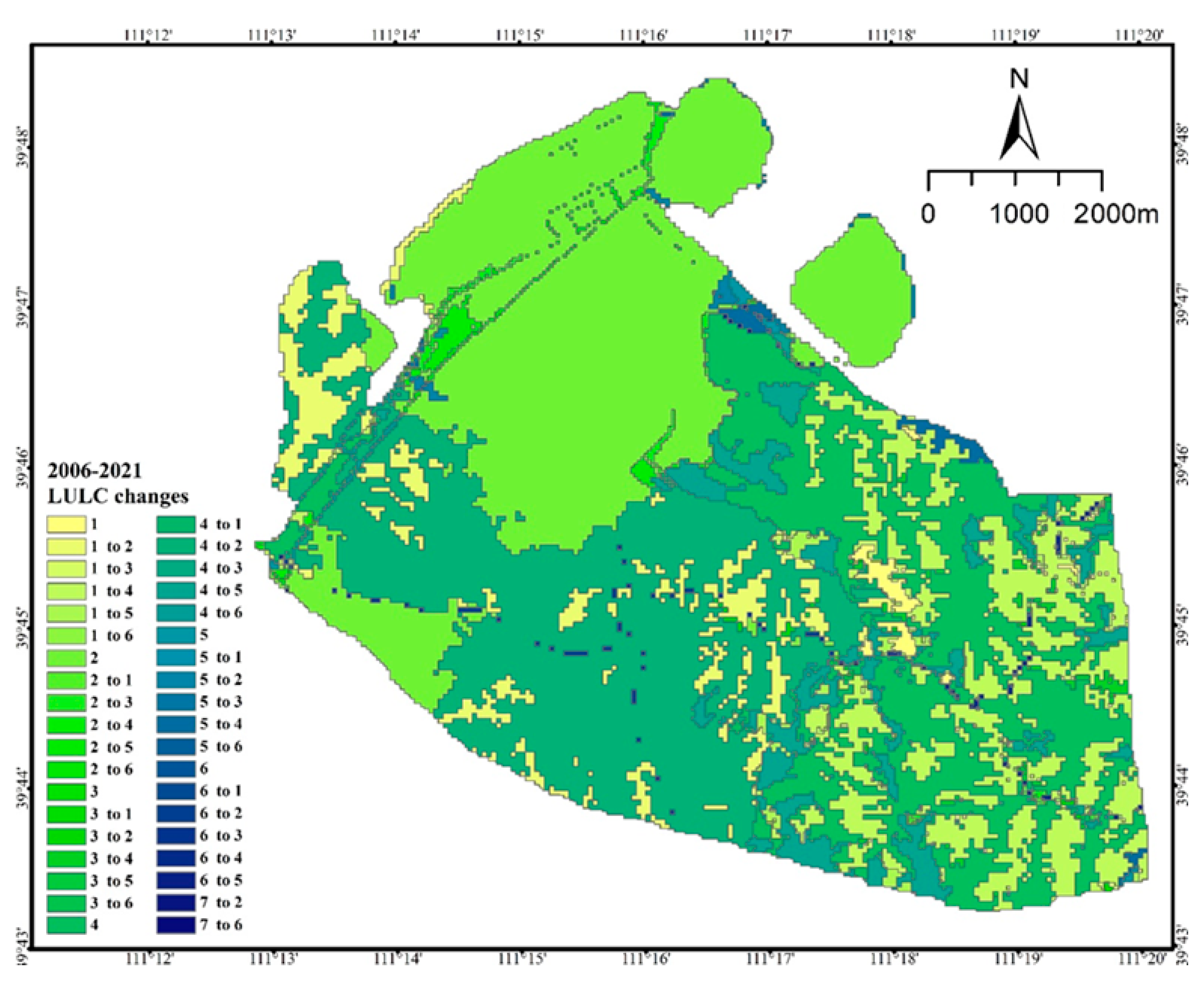

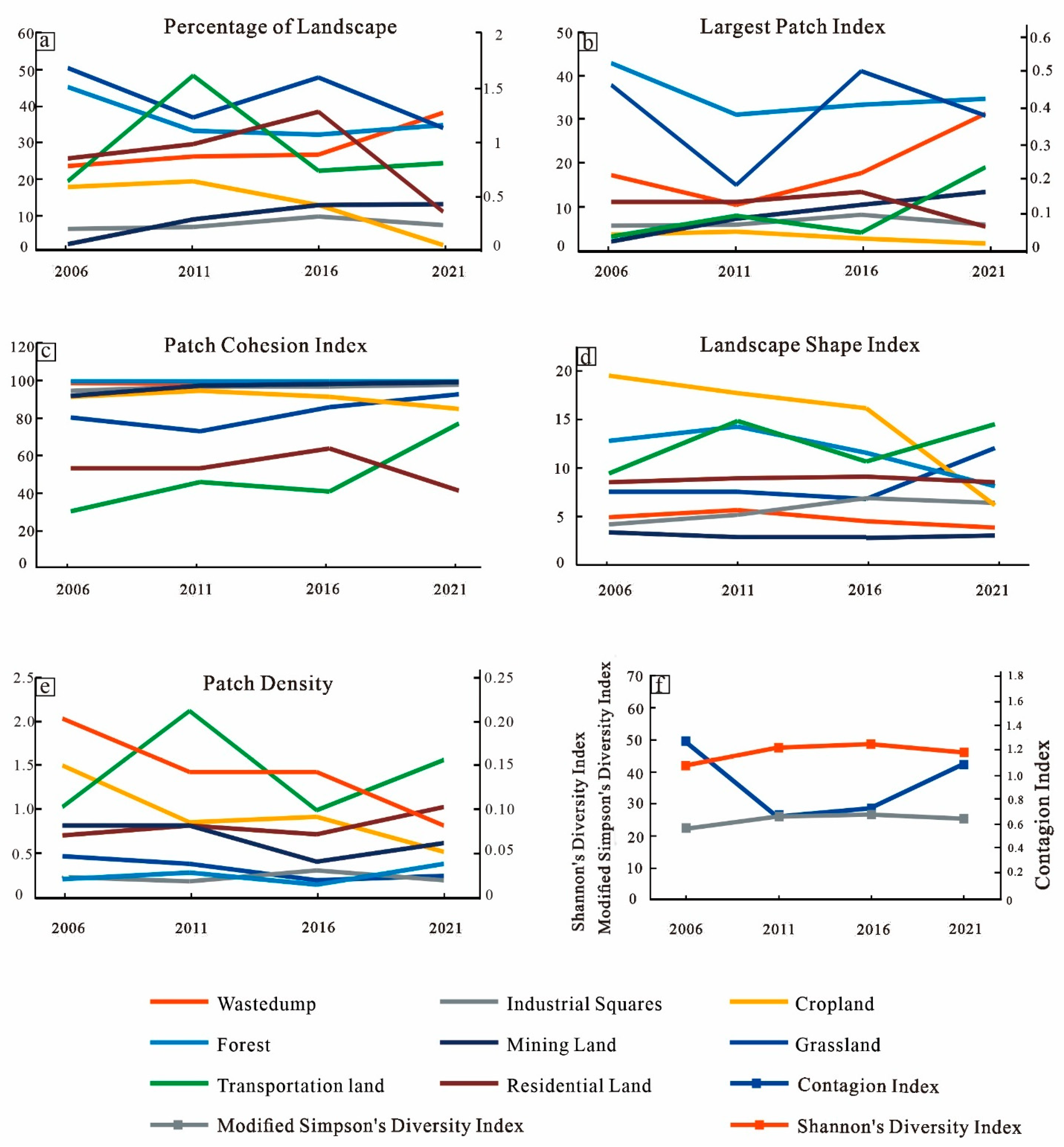

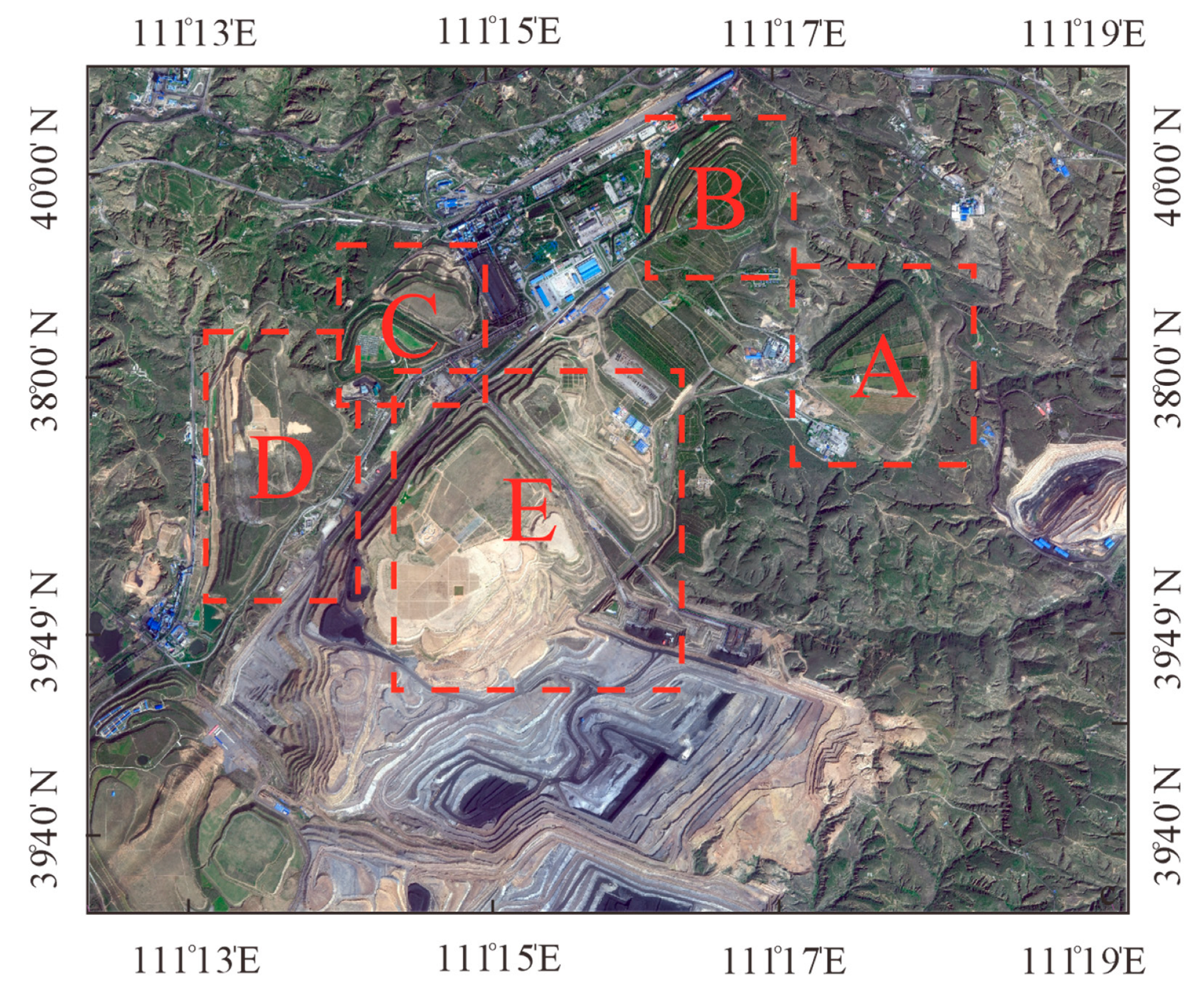

| Year | Overall Classification Accuracy (%) | Kappa Coefficient |
|---|---|---|
| 2006 | 88.39 | 0.87 |
| 2011 | 82.01 | 0.89 |
| 2016 | 83.03 | 0.80 |
| 2021 | 86.23 | 0.86 |
| Average value | 84.92 | 0.86 |
| 2011 | Grassland | Residential Land | Cropland | Transportation Land | Mining Land | Waste Dump | Industrial Squares | Forest | Total | |
|---|---|---|---|---|---|---|---|---|---|---|
| 2006 | ||||||||||
| Grassland | 28.41 | 0.31 | 10.50 | 0.62 | 2.16 | 24.71 | 13.59 | 8.65 | 88.94 | |
| Residential Land | 0.00 | 43.85 | 0.00 | 0.00 | 0.00 | 0.00 | 0.00 | 0.00 | 43.85 | |
| Cropland | 0.00 | 1.54 | 894.70 | 0.93 | 6.79 | 157.51 | 19.15 | 36.75 | 1117.37 | |
| Transportation | 0.00 | 0.00 | 0.00 | 27.18 | 0.00 | 1.85 | 1.54 | 2.16 | 32.74 | |
| Water | 0.00 | 0.00 | 0.00 | 0.00 | 0.00 | 0.31 | 0.00 | 0.00 | 0.31 | |
| Mining Land | 0.00 | 0.00 | 0.62 | 0.00 | 9.27 | 39.53 | 0.00 | 0.00 | 49.41 | |
| Waste Dump | 19.46 | 0.00 | 0.00 | 24.71 | 419.71 | 983.95 | 32.74 | 19.77 | 1500.32 | |
| Industrial Squares | 6.49 | 0.93 | 1.85 | 13.59 | 0.00 | 5.56 | 284.75 | 22.24 | 335.39 | |
| Forest | 10.19 | 4.32 | 319.34 | 18.22 | 74.74 | 466.03 | 12.97 | 2069.20 | 2975.01 | |
| Total | 64.55 | 50.96 | 1227.0 | 85.24 | 512.67 | 1679.45 | 364.73 | 2158.76 | 6143.35 | |
| 2016 | Grassland | Residential Land | Cropland | Transportation Land | Mining Land | Waste Dump | Industrial Squares | Forest | Total | |
|---|---|---|---|---|---|---|---|---|---|---|
| 2011 | ||||||||||
| Grassland | 23.78 | 0.00 | 2.78 | 0.62 | 0.00 | 5.25 | 18.22 | 13.90 | 64.55 | |
| Residential Land | 0.00 | 36.75 | 2.16 | 0.00 | 0.00 | 0.00 | 4.01 | 8.03 | 50.96 | |
| Cropland | 11.43 | 17.60 | 664.61 | 0.00 | 21.00 | 28.72 | 16.37 | 467.27 | 1227.00 | |
| Transportation land | 4.94 | 0.31 | 5.56 | 8.65 | 11.12 | 14.52 | 24.40 | 15.75 | 85.24 | |
| Mining Land | 0.62 | 0.00 | 0.00 | 0.00 | 45.09 | 466.03 | 0.93 | 0.00 | 512.67 | |
| Waste Dump | 17.60 | 0.00 | 0.00 | 8.65 | 346.51 | 1193.65 | 104.39 | 8.65 | 1679.45 | |
| Industrial Squares | 15.75 | 0.93 | 0.00 | 13.90 | 1.24 | 1.24 | 330.14 | 1.54 | 364.73 | |
| Forest | 10.19 | 11.74 | 113.65 | 5.87 | 351.76 | 5.25 | 75.97 | 1584.32 | 2158.76 | |
| Total | 84.31 | 67.33 | 788.76 | 37.68 | 776.72 | 1714.65 | 574.43 | 2099.46 | 6143.35 | |
| 2021 | Grassland | Residential Land | Cropland | Transportation Land | Mining Land | Waste Dump | Industrial Squares | Forest | Total | |
|---|---|---|---|---|---|---|---|---|---|---|
| 2016 | ||||||||||
| Grassland | 16.03 | 0.23 | 0.00 | 1.37 | 0.00 | 29.39 | 7.18 | 30.91 | 85.10 | |
| Residential Land | 0.42 | 7.01 | 0.31 | 0.97 | 4.08 | 0.00 | 0.17 | 54.92 | 67.88 | |
| Cropland | 23.50 | 5.08 | 30.62 | 2.39 | 63.05 | 0.00 | 1.67 | 673.72 | 800.03 | |
| Transportation land | 1.49 | 0.00 | 0.00 | 16.07 | 0.00 | 6.07 | 7.70 | 5.77 | 37.10 | |
| Mining Land | 0.00 | 0.00 | 0.00 | 1.01 | 77.10 | 705.02 | 5.91 | 0.04 | 789.08 | |
| Waste Dump | 6.39 | 0.00 | 0.00 | 6.66 | 12.95 | 1685.79 | 11.90 | 6.40 | 1730.09 | |
| Industrial Squares | 22.47 | 2.62 | 0.00 | 20.24 | 52.19 | 50.10 | 300.83 | 58.47 | 506.92 | |
| Forest | 324.12 | 2.93 | 17.38 | 4.21 | 597.55 | 26.11 | 54.83 | 1100.02 | 2127.16 | |
| Total | 394.41 | 17.86 | 48.32 | 52.93 | 806.93 | 2502.48 | 390.18 | 1930.24 | 6143.35 | |
| 2021 | Grassland | Residential Land | Cropland | Transportation Land | Mining Land | Waste Dump | Industrial Squares | Forest | Total | |
|---|---|---|---|---|---|---|---|---|---|---|
| 2006 | ||||||||||
| Grassland | 9.09 | 0.23 | 0.04 | 1.97 | 0.00 | 19.90 | 4.41 | 35.22 | 70.86 | |
| Residential Land | 0.01 | 4.51 | 0.31 | 0.00 | 5.97 | 0.00 | 0.21 | 33.34 | 44.35 | |
| Cropland | 0.42 | 5.72 | 33.63 | 1.25 | 140.56 | 200.72 | 6.26 | 721.89 | 1110.45 | |
| Transportation land | 0.40 | 0.27 | 0.26 | 0.59 | 10.69 | 5.12 | 0.66 | 14.07 | 32.07 | |
| Water | 0.00 | 0.00 | 0.00 | 0.00 | 0.00 | 0.19 | 0.00 | 0.00 | 0.19 | |
| Mining Land | 0.00 | 0.00 | 0.00 | 0.00 | 1.29 | 48.73 | 0.00 | 0.28 | 50.30 | |
| Waste Dump | 31.99 | 0.00 | 0.00 | 11.50 | 0.00 | 1419.16 | 27.79 | 22.69 | 1513.12 | |
| Industrial Squares | 1.07 | 1.85 | 0.10 | 13.25 | 2.83 | 23.12 | 261.09 | 14.78 | 318.10 | |
| Forest | 17.27 | 5.28 | 5.92 | 12.19 | 645.59 | 787.96 | 92.55 | 1437.16 | 3003.92 | |
| Total | 60.24 | 17.86 | 40.26 | 40.75 | 806.93 | 2504.90 | 392.97 | 2279.43 | 6143.35 | |
| Indicators | 2006 | 2011 | 2016 | 2021 |
|---|---|---|---|---|
| PC1 | PC1 | PC1 | PC1 | |
| NDVI | 0.513 | 0.572 | 0.509 | 0.554 |
| Wet | 0.492 | 0.511 | 0.521 | 0.516 |
| NDSI | −0.541 | −0.636 | −0.599 | −0.612 |
| LST | −0.423 | −0.245 | −0.312 | −0.383 |
| Eigenvalue | 0.051 | 0.059 | 0.063 | 0.059 |
| Percent eigenvalue % | 70.32 | 71.56 | 75.36 | 74.68 |
| RSEI Level | 2006 | 2011 | 2016 | 2021 | ||||
|---|---|---|---|---|---|---|---|---|
| Area (hm2) | Pct. (%) | Area (hm2) | Pct. (%) | Area (hm2) | Pct. (%) | Area (hm2) | Pct. (%) | |
| Poor | 603.92 | 9.83% | 402.49 | 6.55% | 214.00 | 3.48% | 226.29 | 3.68% |
| Fair | 851.46 | 13.86% | 846.29 | 13.78% | 2322.42 | 37.80% | 1993.08 | 32.44% |
| Moderate | 2552.47 | 41.55% | 2432.28 | 39.59% | 2017.47 | 32.84% | 1964.94 | 31.98% |
| Good | 1827.55 | 29.75% | 2219.82 | 36.13% | 1099.58 | 17.90% | 1204.96 | 19.61% |
| Excellent | 307.95 | 5.01% | 219.64 | 3.58% | 463.99 | 7.55% | 728.71 | 11.86% |
| Year | 2006 | 2011 | 2016 | 2021 |
|---|---|---|---|---|
| RSEI | 0.5002 | 0.5005 | 0.4993 | 0.5009 |
| LST | 0.4999 | 0.5006 | 0.5005 | 0.4998 |
| NDVI | 0.5002 | 0.4989 | 0.5003 | 0.5006 |
| WET | 0.5003 | 0.5005 | 0.5011 | 0.5006 |
| NDBSI | 0.4998 | 0.4996 | 0.5013 | 0.5000 |
Disclaimer/Publisher’s Note: The statements, opinions and data contained in all publications are solely those of the individual author(s) and contributor(s) and not of MDPI and/or the editor(s). MDPI and/or the editor(s) disclaim responsibility for any injury to people or property resulting from any ideas, methods, instructions or products referred to in the content. |
© 2023 by the authors. Licensee MDPI, Basel, Switzerland. This article is an open access article distributed under the terms and conditions of the Creative Commons Attribution (CC BY) license (https://creativecommons.org/licenses/by/4.0/).
Share and Cite
Zhao, Y.; Wang, Y.; Zhang, Z.; Zhou, Y.; Huang, H.; Chang, M. The Evolution of Landscape Patterns and Its Ecological Effects of Open-Pit Mining: A Case Study in the Heidaigou Mining Area, China. Int. J. Environ. Res. Public Health 2023, 20, 4394. https://doi.org/10.3390/ijerph20054394
Zhao Y, Wang Y, Zhang Z, Zhou Y, Huang H, Chang M. The Evolution of Landscape Patterns and Its Ecological Effects of Open-Pit Mining: A Case Study in the Heidaigou Mining Area, China. International Journal of Environmental Research and Public Health. 2023; 20(5):4394. https://doi.org/10.3390/ijerph20054394
Chicago/Turabian StyleZhao, Yuxia, Yang Wang, Zifan Zhang, Yi Zhou, Haoqing Huang, and Ming Chang. 2023. "The Evolution of Landscape Patterns and Its Ecological Effects of Open-Pit Mining: A Case Study in the Heidaigou Mining Area, China" International Journal of Environmental Research and Public Health 20, no. 5: 4394. https://doi.org/10.3390/ijerph20054394
APA StyleZhao, Y., Wang, Y., Zhang, Z., Zhou, Y., Huang, H., & Chang, M. (2023). The Evolution of Landscape Patterns and Its Ecological Effects of Open-Pit Mining: A Case Study in the Heidaigou Mining Area, China. International Journal of Environmental Research and Public Health, 20(5), 4394. https://doi.org/10.3390/ijerph20054394





